University Social Policy Portfolio: Unit 7, Equality Act and Welfare
VerifiedAdded on 2020/02/03
|10
|3072
|68
Report
AI Summary
This portfolio analyzes significant changes in social policy, focusing on the origins of the welfare state and the Equality Act 2010. It begins by defining social policy, differentiating it from organizational policy, and exploring the evolution of welfare provision since World War II, including key agreements, disagreements, and the reasons behind the breakdown of consensus. The report then delves into the Equality Act 2010, explaining its relevance to health and social care, listing its nine protected characteristics, and examining a current issue related to age discrimination. It details the process of the Act's formulation, the influences of different ideologies, its objectives, and its impact on the chosen characteristic. The report provides a comprehensive overview of social policy, the Equality Act, and their implications for health and social care.
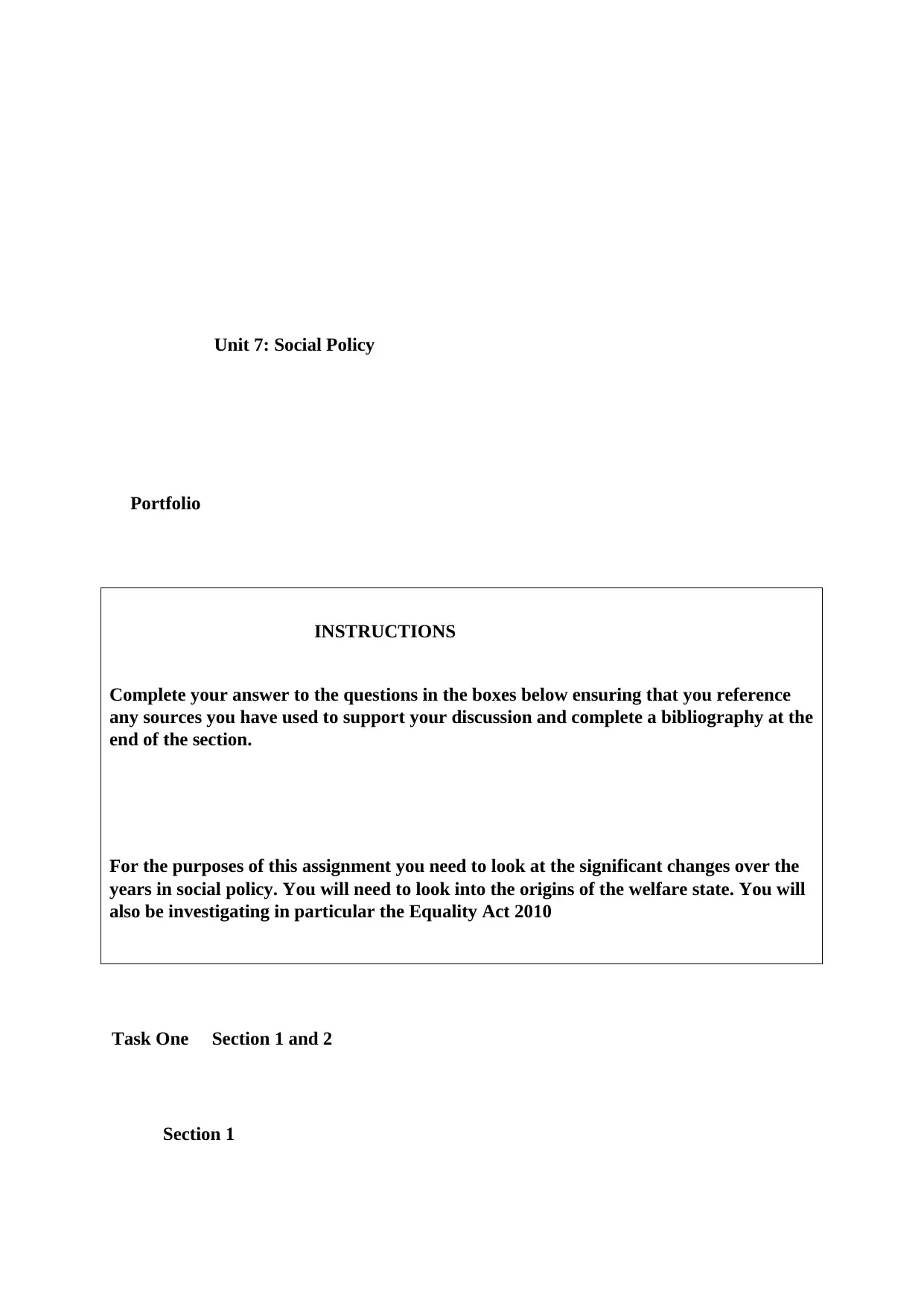
Unit 7: Social Policy
Portfolio
INSTRUCTIONS
Complete your answer to the questions in the boxes below ensuring that you reference
any sources you have used to support your discussion and complete a bibliography at the
end of the section.
For the purposes of this assignment you need to look at the significant changes over the
years in social policy. You will need to look into the origins of the welfare state. You will
also be investigating in particular the Equality Act 2010
Task One Section 1 and 2
Section 1
Portfolio
INSTRUCTIONS
Complete your answer to the questions in the boxes below ensuring that you reference
any sources you have used to support your discussion and complete a bibliography at the
end of the section.
For the purposes of this assignment you need to look at the significant changes over the
years in social policy. You will need to look into the origins of the welfare state. You will
also be investigating in particular the Equality Act 2010
Task One Section 1 and 2
Section 1
Paraphrase This Document
Need a fresh take? Get an instant paraphrase of this document with our AI Paraphraser
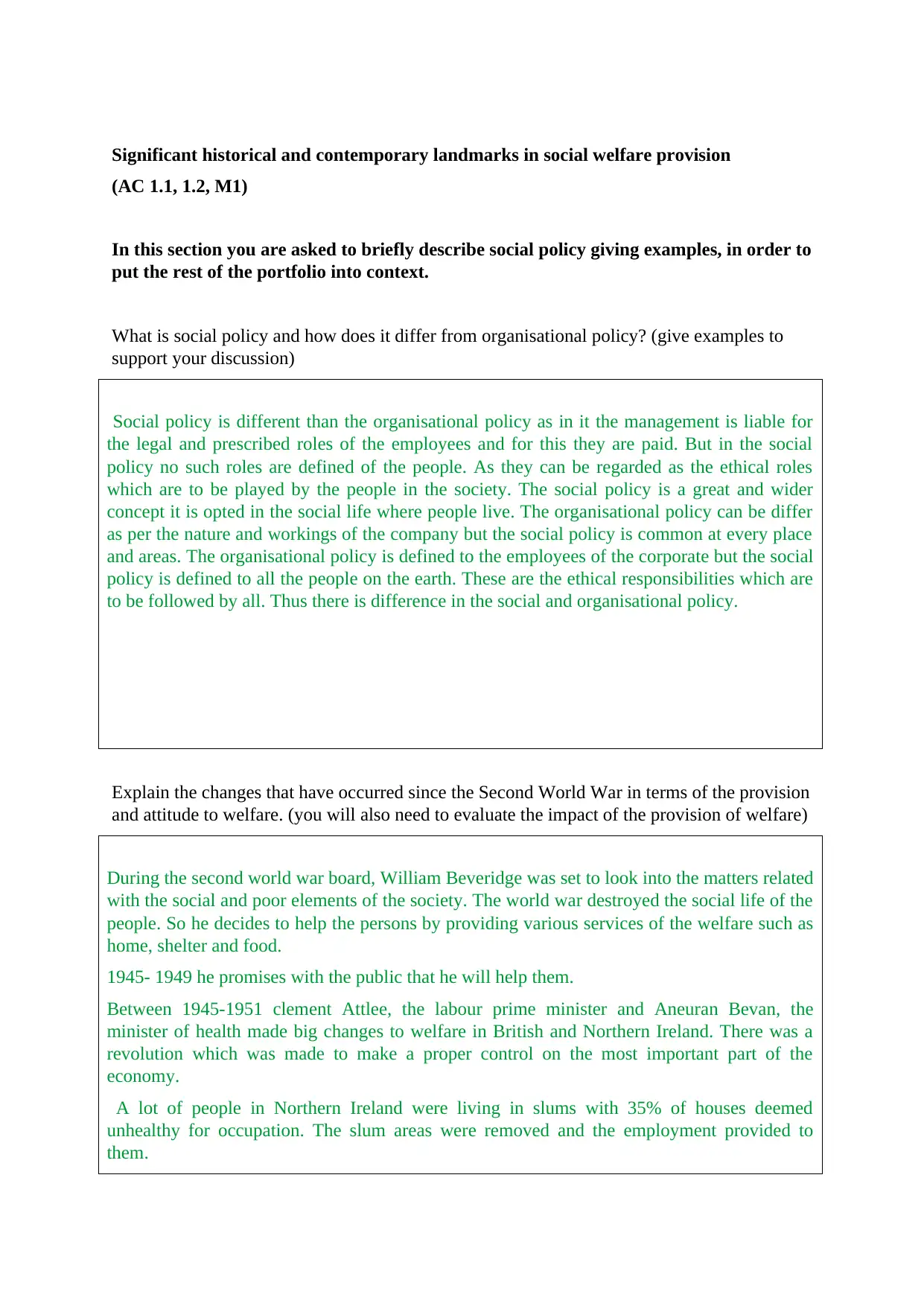
Significant historical and contemporary landmarks in social welfare provision
(AC 1.1, 1.2, M1)
In this section you are asked to briefly describe social policy giving examples, in order to
put the rest of the portfolio into context.
What is social policy and how does it differ from organisational policy? (give examples to
support your discussion)
Social policy is different than the organisational policy as in it the management is liable for
the legal and prescribed roles of the employees and for this they are paid. But in the social
policy no such roles are defined of the people. As they can be regarded as the ethical roles
which are to be played by the people in the society. The social policy is a great and wider
concept it is opted in the social life where people live. The organisational policy can be differ
as per the nature and workings of the company but the social policy is common at every place
and areas. The organisational policy is defined to the employees of the corporate but the social
policy is defined to all the people on the earth. These are the ethical responsibilities which are
to be followed by all. Thus there is difference in the social and organisational policy.
Explain the changes that have occurred since the Second World War in terms of the provision
and attitude to welfare. (you will also need to evaluate the impact of the provision of welfare)
During the second world war board, William Beveridge was set to look into the matters related
with the social and poor elements of the society. The world war destroyed the social life of the
people. So he decides to help the persons by providing various services of the welfare such as
home, shelter and food.
1945- 1949 he promises with the public that he will help them.
Between 1945-1951 clement Attlee, the labour prime minister and Aneuran Bevan, the
minister of health made big changes to welfare in British and Northern Ireland. There was a
revolution which was made to make a proper control on the most important part of the
economy.
A lot of people in Northern Ireland were living in slums with 35% of houses deemed
unhealthy for occupation. The slum areas were removed and the employment provided to
them.
(AC 1.1, 1.2, M1)
In this section you are asked to briefly describe social policy giving examples, in order to
put the rest of the portfolio into context.
What is social policy and how does it differ from organisational policy? (give examples to
support your discussion)
Social policy is different than the organisational policy as in it the management is liable for
the legal and prescribed roles of the employees and for this they are paid. But in the social
policy no such roles are defined of the people. As they can be regarded as the ethical roles
which are to be played by the people in the society. The social policy is a great and wider
concept it is opted in the social life where people live. The organisational policy can be differ
as per the nature and workings of the company but the social policy is common at every place
and areas. The organisational policy is defined to the employees of the corporate but the social
policy is defined to all the people on the earth. These are the ethical responsibilities which are
to be followed by all. Thus there is difference in the social and organisational policy.
Explain the changes that have occurred since the Second World War in terms of the provision
and attitude to welfare. (you will also need to evaluate the impact of the provision of welfare)
During the second world war board, William Beveridge was set to look into the matters related
with the social and poor elements of the society. The world war destroyed the social life of the
people. So he decides to help the persons by providing various services of the welfare such as
home, shelter and food.
1945- 1949 he promises with the public that he will help them.
Between 1945-1951 clement Attlee, the labour prime minister and Aneuran Bevan, the
minister of health made big changes to welfare in British and Northern Ireland. There was a
revolution which was made to make a proper control on the most important part of the
economy.
A lot of people in Northern Ireland were living in slums with 35% of houses deemed
unhealthy for occupation. The slum areas were removed and the employment provided to
them.
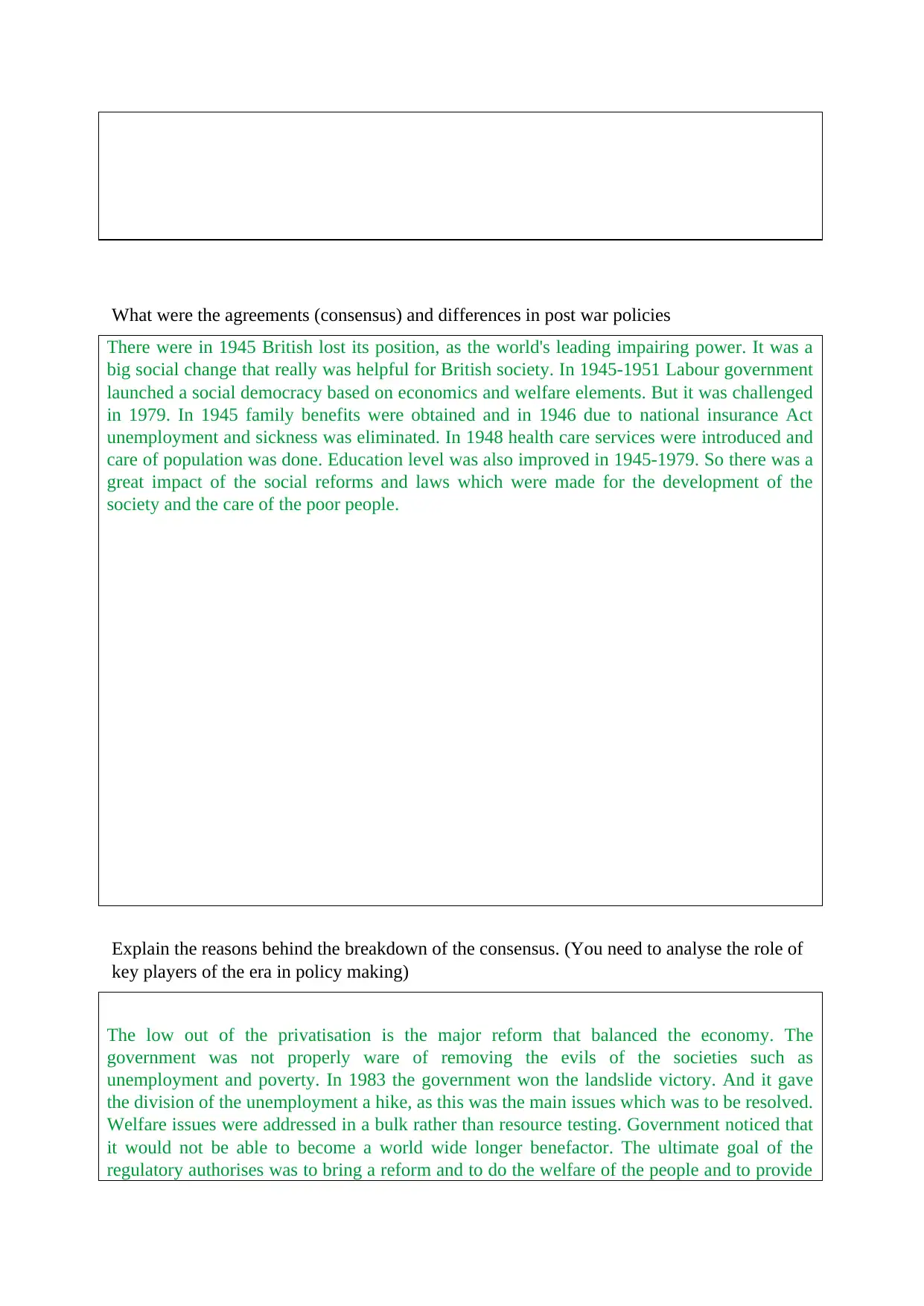
What were the agreements (consensus) and differences in post war policies
There were in 1945 British lost its position, as the world's leading impairing power. It was a
big social change that really was helpful for British society. In 1945-1951 Labour government
launched a social democracy based on economics and welfare elements. But it was challenged
in 1979. In 1945 family benefits were obtained and in 1946 due to national insurance Act
unemployment and sickness was eliminated. In 1948 health care services were introduced and
care of population was done. Education level was also improved in 1945-1979. So there was a
great impact of the social reforms and laws which were made for the development of the
society and the care of the poor people.
Explain the reasons behind the breakdown of the consensus. (You need to analyse the role of
key players of the era in policy making)
The low out of the privatisation is the major reform that balanced the economy. The
government was not properly ware of removing the evils of the societies such as
unemployment and poverty. In 1983 the government won the landslide victory. And it gave
the division of the unemployment a hike, as this was the main issues which was to be resolved.
Welfare issues were addressed in a bulk rather than resource testing. Government noticed that
it would not be able to become a world wide longer benefactor. The ultimate goal of the
regulatory authorises was to bring a reform and to do the welfare of the people and to provide
There were in 1945 British lost its position, as the world's leading impairing power. It was a
big social change that really was helpful for British society. In 1945-1951 Labour government
launched a social democracy based on economics and welfare elements. But it was challenged
in 1979. In 1945 family benefits were obtained and in 1946 due to national insurance Act
unemployment and sickness was eliminated. In 1948 health care services were introduced and
care of population was done. Education level was also improved in 1945-1979. So there was a
great impact of the social reforms and laws which were made for the development of the
society and the care of the poor people.
Explain the reasons behind the breakdown of the consensus. (You need to analyse the role of
key players of the era in policy making)
The low out of the privatisation is the major reform that balanced the economy. The
government was not properly ware of removing the evils of the societies such as
unemployment and poverty. In 1983 the government won the landslide victory. And it gave
the division of the unemployment a hike, as this was the main issues which was to be resolved.
Welfare issues were addressed in a bulk rather than resource testing. Government noticed that
it would not be able to become a world wide longer benefactor. The ultimate goal of the
regulatory authorises was to bring a reform and to do the welfare of the people and to provide
⊘ This is a preview!⊘
Do you want full access?
Subscribe today to unlock all pages.

Trusted by 1+ million students worldwide
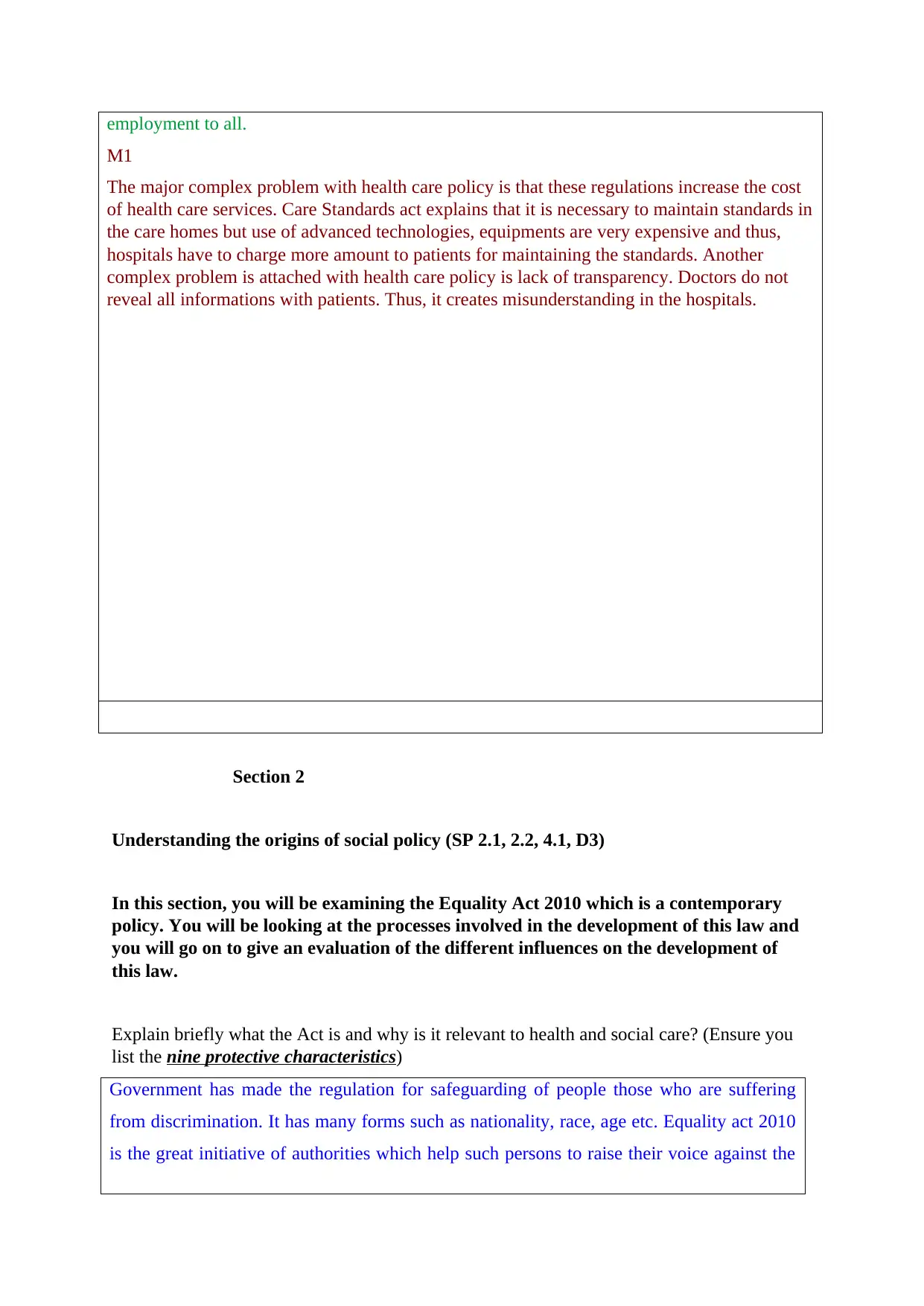
employment to all.
M1
The major complex problem with health care policy is that these regulations increase the cost
of health care services. Care Standards act explains that it is necessary to maintain standards in
the care homes but use of advanced technologies, equipments are very expensive and thus,
hospitals have to charge more amount to patients for maintaining the standards. Another
complex problem is attached with health care policy is lack of transparency. Doctors do not
reveal all informations with patients. Thus, it creates misunderstanding in the hospitals.
Section 2
Understanding the origins of social policy (SP 2.1, 2.2, 4.1, D3)
In this section, you will be examining the Equality Act 2010 which is a contemporary
policy. You will be looking at the processes involved in the development of this law and
you will go on to give an evaluation of the different influences on the development of
this law.
Explain briefly what the Act is and why is it relevant to health and social care? (Ensure you
list the nine protective characteristics)
Government has made the regulation for safeguarding of people those who are suffering
from discrimination. It has many forms such as nationality, race, age etc. Equality act 2010
is the great initiative of authorities which help such persons to raise their voice against the
M1
The major complex problem with health care policy is that these regulations increase the cost
of health care services. Care Standards act explains that it is necessary to maintain standards in
the care homes but use of advanced technologies, equipments are very expensive and thus,
hospitals have to charge more amount to patients for maintaining the standards. Another
complex problem is attached with health care policy is lack of transparency. Doctors do not
reveal all informations with patients. Thus, it creates misunderstanding in the hospitals.
Section 2
Understanding the origins of social policy (SP 2.1, 2.2, 4.1, D3)
In this section, you will be examining the Equality Act 2010 which is a contemporary
policy. You will be looking at the processes involved in the development of this law and
you will go on to give an evaluation of the different influences on the development of
this law.
Explain briefly what the Act is and why is it relevant to health and social care? (Ensure you
list the nine protective characteristics)
Government has made the regulation for safeguarding of people those who are suffering
from discrimination. It has many forms such as nationality, race, age etc. Equality act 2010
is the great initiative of authorities which help such persons to raise their voice against the
Paraphrase This Document
Need a fresh take? Get an instant paraphrase of this document with our AI Paraphraser
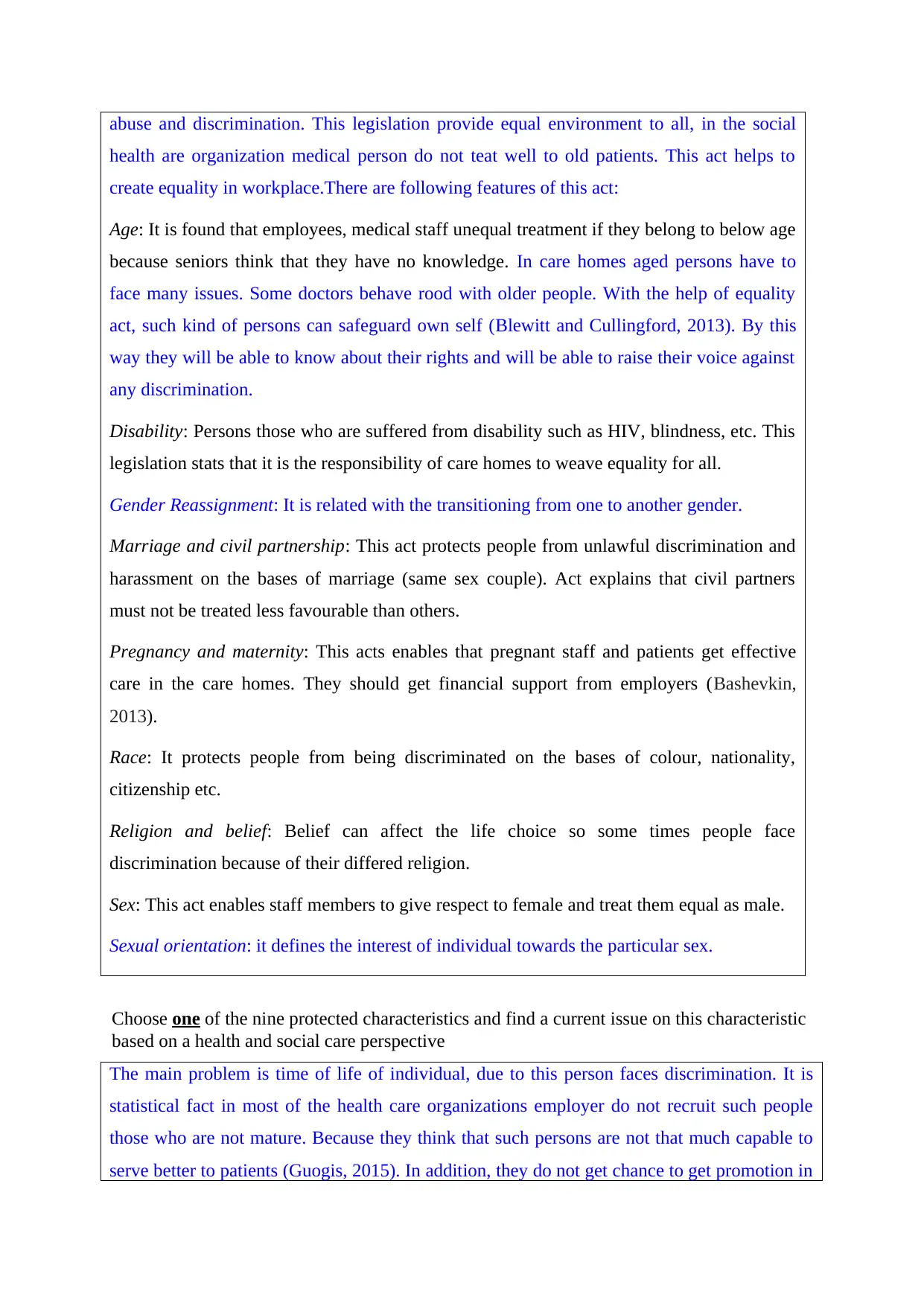
abuse and discrimination. This legislation provide equal environment to all, in the social
health are organization medical person do not teat well to old patients. This act helps to
create equality in workplace.There are following features of this act:
Age: It is found that employees, medical staff unequal treatment if they belong to below age
because seniors think that they have no knowledge. In care homes aged persons have to
face many issues. Some doctors behave rood with older people. With the help of equality
act, such kind of persons can safeguard own self (Blewitt and Cullingford, 2013). By this
way they will be able to know about their rights and will be able to raise their voice against
any discrimination.
Disability: Persons those who are suffered from disability such as HIV, blindness, etc. This
legislation stats that it is the responsibility of care homes to weave equality for all.
Gender Reassignment: It is related with the transitioning from one to another gender.
Marriage and civil partnership: This act protects people from unlawful discrimination and
harassment on the bases of marriage (same sex couple). Act explains that civil partners
must not be treated less favourable than others.
Pregnancy and maternity: This acts enables that pregnant staff and patients get effective
care in the care homes. They should get financial support from employers (Bashevkin,
2013).
Race: It protects people from being discriminated on the bases of colour, nationality,
citizenship etc.
Religion and belief: Belief can affect the life choice so some times people face
discrimination because of their differed religion.
Sex: This act enables staff members to give respect to female and treat them equal as male.
Sexual orientation: it defines the interest of individual towards the particular sex.
Choose one of the nine protected characteristics and find a current issue on this characteristic
based on a health and social care perspective
The main problem is time of life of individual, due to this person faces discrimination. It is
statistical fact in most of the health care organizations employer do not recruit such people
those who are not mature. Because they think that such persons are not that much capable to
serve better to patients (Guogis, 2015). In addition, they do not get chance to get promotion in
health are organization medical person do not teat well to old patients. This act helps to
create equality in workplace.There are following features of this act:
Age: It is found that employees, medical staff unequal treatment if they belong to below age
because seniors think that they have no knowledge. In care homes aged persons have to
face many issues. Some doctors behave rood with older people. With the help of equality
act, such kind of persons can safeguard own self (Blewitt and Cullingford, 2013). By this
way they will be able to know about their rights and will be able to raise their voice against
any discrimination.
Disability: Persons those who are suffered from disability such as HIV, blindness, etc. This
legislation stats that it is the responsibility of care homes to weave equality for all.
Gender Reassignment: It is related with the transitioning from one to another gender.
Marriage and civil partnership: This act protects people from unlawful discrimination and
harassment on the bases of marriage (same sex couple). Act explains that civil partners
must not be treated less favourable than others.
Pregnancy and maternity: This acts enables that pregnant staff and patients get effective
care in the care homes. They should get financial support from employers (Bashevkin,
2013).
Race: It protects people from being discriminated on the bases of colour, nationality,
citizenship etc.
Religion and belief: Belief can affect the life choice so some times people face
discrimination because of their differed religion.
Sex: This act enables staff members to give respect to female and treat them equal as male.
Sexual orientation: it defines the interest of individual towards the particular sex.
Choose one of the nine protected characteristics and find a current issue on this characteristic
based on a health and social care perspective
The main problem is time of life of individual, due to this person faces discrimination. It is
statistical fact in most of the health care organizations employer do not recruit such people
those who are not mature. Because they think that such persons are not that much capable to
serve better to patients (Guogis, 2015). In addition, they do not get chance to get promotion in
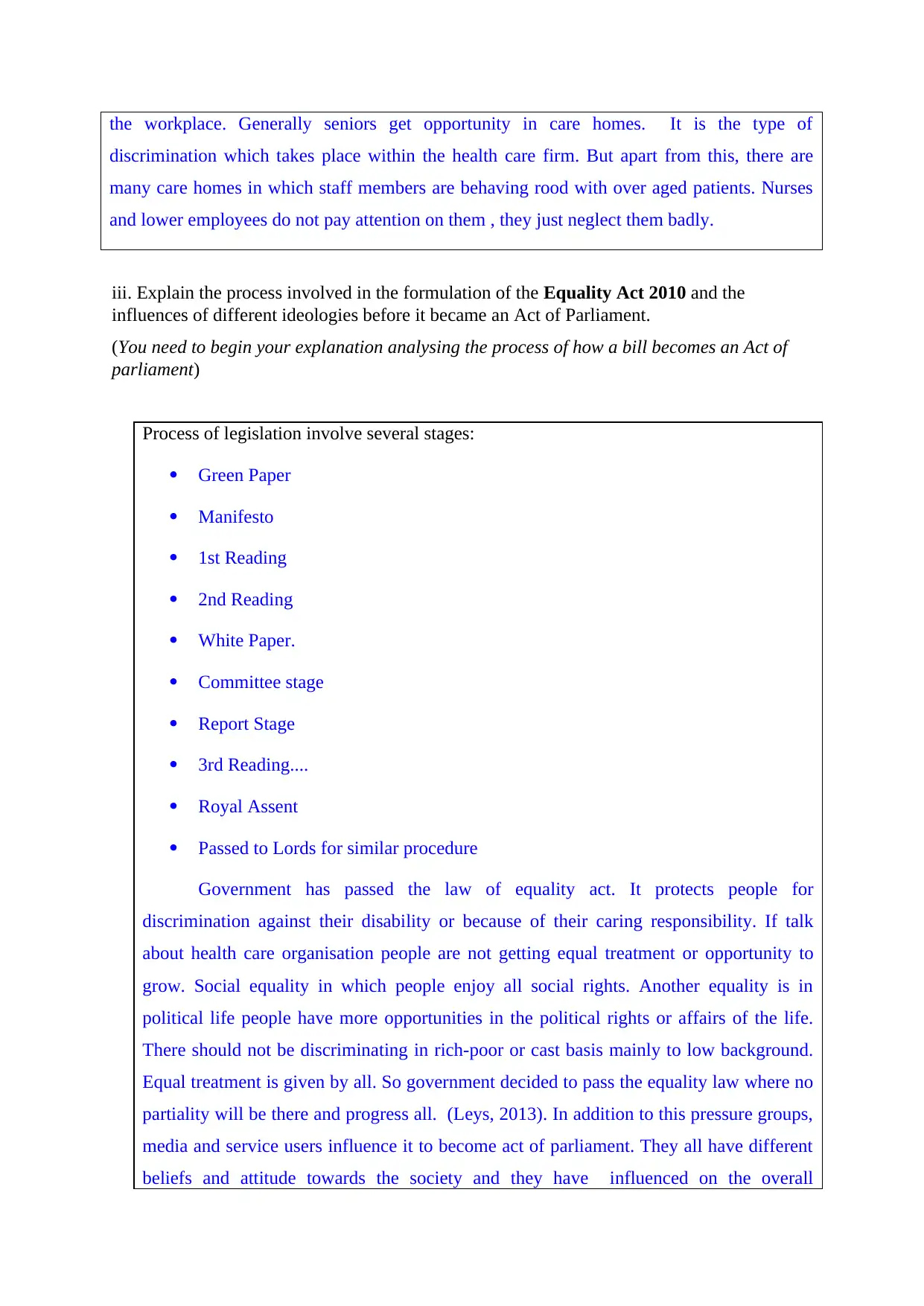
the workplace. Generally seniors get opportunity in care homes. It is the type of
discrimination which takes place within the health care firm. But apart from this, there are
many care homes in which staff members are behaving rood with over aged patients. Nurses
and lower employees do not pay attention on them , they just neglect them badly.
iii. Explain the process involved in the formulation of the Equality Act 2010 and the
influences of different ideologies before it became an Act of Parliament.
(You need to begin your explanation analysing the process of how a bill becomes an Act of
parliament)
Process of legislation involve several stages:
Green Paper
Manifesto
1st Reading
2nd Reading
White Paper.
Committee stage
Report Stage
3rd Reading....
Royal Assent
Passed to Lords for similar procedure
Government has passed the law of equality act. It protects people for
discrimination against their disability or because of their caring responsibility. If talk
about health care organisation people are not getting equal treatment or opportunity to
grow. Social equality in which people enjoy all social rights. Another equality is in
political life people have more opportunities in the political rights or affairs of the life.
There should not be discriminating in rich-poor or cast basis mainly to low background.
Equal treatment is given by all. So government decided to pass the equality law where no
partiality will be there and progress all. (Leys, 2013). In addition to this pressure groups,
media and service users influence it to become act of parliament. They all have different
beliefs and attitude towards the society and they have influenced on the overall
discrimination which takes place within the health care firm. But apart from this, there are
many care homes in which staff members are behaving rood with over aged patients. Nurses
and lower employees do not pay attention on them , they just neglect them badly.
iii. Explain the process involved in the formulation of the Equality Act 2010 and the
influences of different ideologies before it became an Act of Parliament.
(You need to begin your explanation analysing the process of how a bill becomes an Act of
parliament)
Process of legislation involve several stages:
Green Paper
Manifesto
1st Reading
2nd Reading
White Paper.
Committee stage
Report Stage
3rd Reading....
Royal Assent
Passed to Lords for similar procedure
Government has passed the law of equality act. It protects people for
discrimination against their disability or because of their caring responsibility. If talk
about health care organisation people are not getting equal treatment or opportunity to
grow. Social equality in which people enjoy all social rights. Another equality is in
political life people have more opportunities in the political rights or affairs of the life.
There should not be discriminating in rich-poor or cast basis mainly to low background.
Equal treatment is given by all. So government decided to pass the equality law where no
partiality will be there and progress all. (Leys, 2013). In addition to this pressure groups,
media and service users influence it to become act of parliament. They all have different
beliefs and attitude towards the society and they have influenced on the overall
⊘ This is a preview!⊘
Do you want full access?
Subscribe today to unlock all pages.

Trusted by 1+ million students worldwide
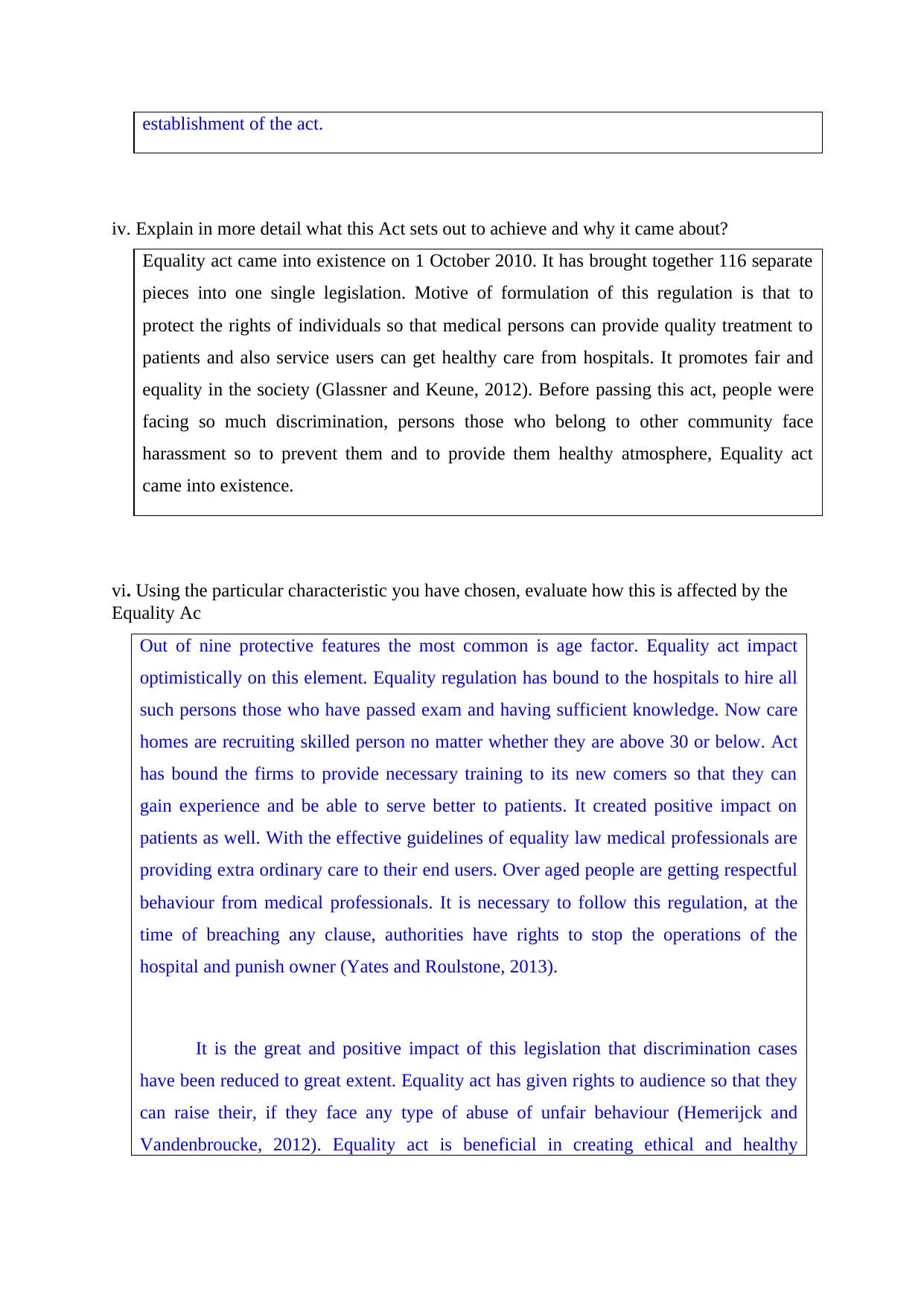
establishment of the act.
iv. Explain in more detail what this Act sets out to achieve and why it came about?
Equality act came into existence on 1 October 2010. It has brought together 116 separate
pieces into one single legislation. Motive of formulation of this regulation is that to
protect the rights of individuals so that medical persons can provide quality treatment to
patients and also service users can get healthy care from hospitals. It promotes fair and
equality in the society (Glassner and Keune, 2012). Before passing this act, people were
facing so much discrimination, persons those who belong to other community face
harassment so to prevent them and to provide them healthy atmosphere, Equality act
came into existence.
vi. Using the particular characteristic you have chosen, evaluate how this is affected by the
Equality Ac
Out of nine protective features the most common is age factor. Equality act impact
optimistically on this element. Equality regulation has bound to the hospitals to hire all
such persons those who have passed exam and having sufficient knowledge. Now care
homes are recruiting skilled person no matter whether they are above 30 or below. Act
has bound the firms to provide necessary training to its new comers so that they can
gain experience and be able to serve better to patients. It created positive impact on
patients as well. With the effective guidelines of equality law medical professionals are
providing extra ordinary care to their end users. Over aged people are getting respectful
behaviour from medical professionals. It is necessary to follow this regulation, at the
time of breaching any clause, authorities have rights to stop the operations of the
hospital and punish owner (Yates and Roulstone, 2013).
It is the great and positive impact of this legislation that discrimination cases
have been reduced to great extent. Equality act has given rights to audience so that they
can raise their, if they face any type of abuse of unfair behaviour (Hemerijck and
Vandenbroucke, 2012). Equality act is beneficial in creating ethical and healthy
iv. Explain in more detail what this Act sets out to achieve and why it came about?
Equality act came into existence on 1 October 2010. It has brought together 116 separate
pieces into one single legislation. Motive of formulation of this regulation is that to
protect the rights of individuals so that medical persons can provide quality treatment to
patients and also service users can get healthy care from hospitals. It promotes fair and
equality in the society (Glassner and Keune, 2012). Before passing this act, people were
facing so much discrimination, persons those who belong to other community face
harassment so to prevent them and to provide them healthy atmosphere, Equality act
came into existence.
vi. Using the particular characteristic you have chosen, evaluate how this is affected by the
Equality Ac
Out of nine protective features the most common is age factor. Equality act impact
optimistically on this element. Equality regulation has bound to the hospitals to hire all
such persons those who have passed exam and having sufficient knowledge. Now care
homes are recruiting skilled person no matter whether they are above 30 or below. Act
has bound the firms to provide necessary training to its new comers so that they can
gain experience and be able to serve better to patients. It created positive impact on
patients as well. With the effective guidelines of equality law medical professionals are
providing extra ordinary care to their end users. Over aged people are getting respectful
behaviour from medical professionals. It is necessary to follow this regulation, at the
time of breaching any clause, authorities have rights to stop the operations of the
hospital and punish owner (Yates and Roulstone, 2013).
It is the great and positive impact of this legislation that discrimination cases
have been reduced to great extent. Equality act has given rights to audience so that they
can raise their, if they face any type of abuse of unfair behaviour (Hemerijck and
Vandenbroucke, 2012). Equality act is beneficial in creating ethical and healthy
Paraphrase This Document
Need a fresh take? Get an instant paraphrase of this document with our AI Paraphraser
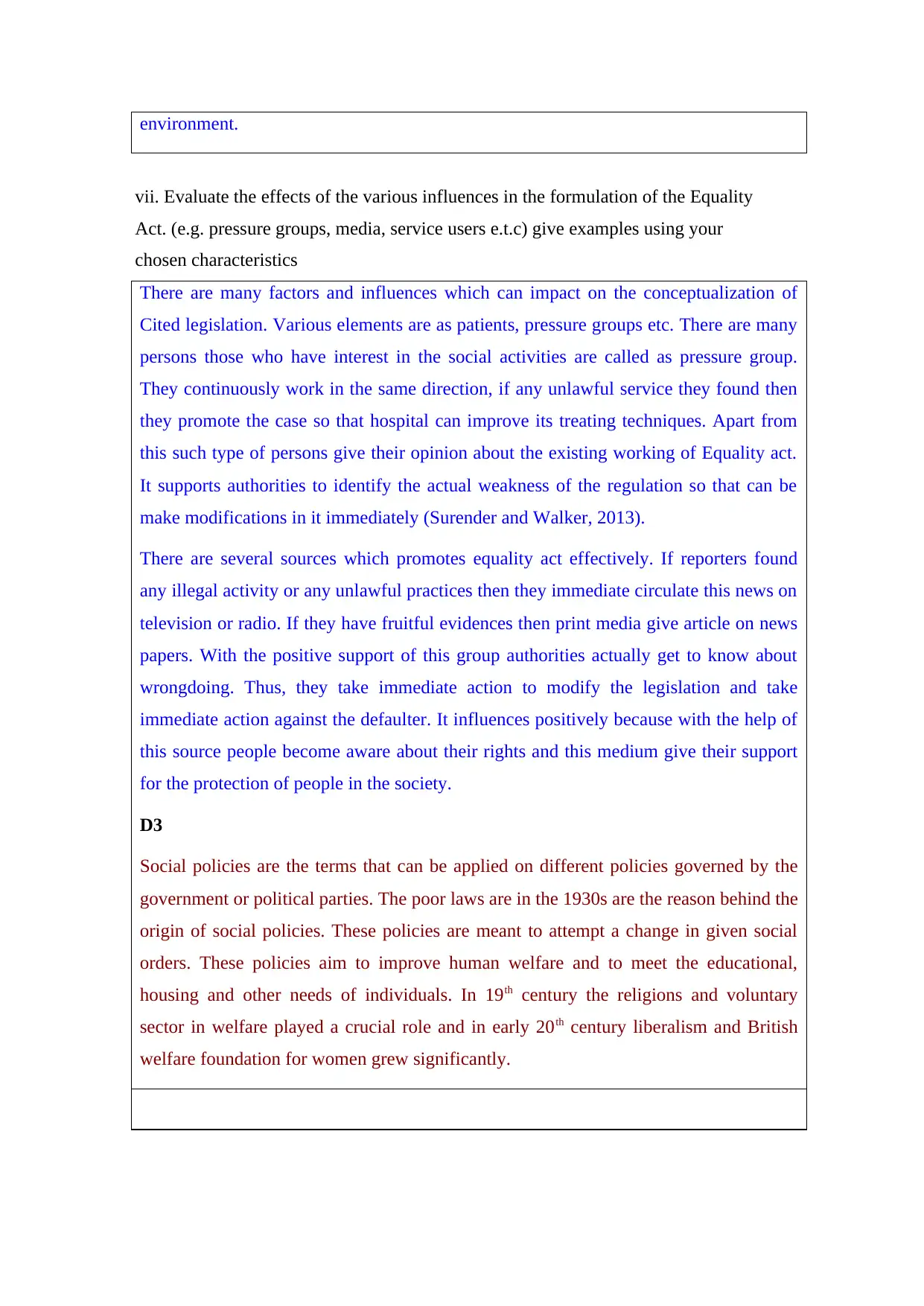
environment.
vii. Evaluate the effects of the various influences in the formulation of the Equality
Act. (e.g. pressure groups, media, service users e.t.c) give examples using your
chosen characteristics
There are many factors and influences which can impact on the conceptualization of
Cited legislation. Various elements are as patients, pressure groups etc. There are many
persons those who have interest in the social activities are called as pressure group.
They continuously work in the same direction, if any unlawful service they found then
they promote the case so that hospital can improve its treating techniques. Apart from
this such type of persons give their opinion about the existing working of Equality act.
It supports authorities to identify the actual weakness of the regulation so that can be
make modifications in it immediately (Surender and Walker, 2013).
There are several sources which promotes equality act effectively. If reporters found
any illegal activity or any unlawful practices then they immediate circulate this news on
television or radio. If they have fruitful evidences then print media give article on news
papers. With the positive support of this group authorities actually get to know about
wrongdoing. Thus, they take immediate action to modify the legislation and take
immediate action against the defaulter. It influences positively because with the help of
this source people become aware about their rights and this medium give their support
for the protection of people in the society.
D3
Social policies are the terms that can be applied on different policies governed by the
government or political parties. The poor laws are in the 1930s are the reason behind the
origin of social policies. These policies are meant to attempt a change in given social
orders. These policies aim to improve human welfare and to meet the educational,
housing and other needs of individuals. In 19th century the religions and voluntary
sector in welfare played a crucial role and in early 20th century liberalism and British
welfare foundation for women grew significantly.
vii. Evaluate the effects of the various influences in the formulation of the Equality
Act. (e.g. pressure groups, media, service users e.t.c) give examples using your
chosen characteristics
There are many factors and influences which can impact on the conceptualization of
Cited legislation. Various elements are as patients, pressure groups etc. There are many
persons those who have interest in the social activities are called as pressure group.
They continuously work in the same direction, if any unlawful service they found then
they promote the case so that hospital can improve its treating techniques. Apart from
this such type of persons give their opinion about the existing working of Equality act.
It supports authorities to identify the actual weakness of the regulation so that can be
make modifications in it immediately (Surender and Walker, 2013).
There are several sources which promotes equality act effectively. If reporters found
any illegal activity or any unlawful practices then they immediate circulate this news on
television or radio. If they have fruitful evidences then print media give article on news
papers. With the positive support of this group authorities actually get to know about
wrongdoing. Thus, they take immediate action to modify the legislation and take
immediate action against the defaulter. It influences positively because with the help of
this source people become aware about their rights and this medium give their support
for the protection of people in the society.
D3
Social policies are the terms that can be applied on different policies governed by the
government or political parties. The poor laws are in the 1930s are the reason behind the
origin of social policies. These policies are meant to attempt a change in given social
orders. These policies aim to improve human welfare and to meet the educational,
housing and other needs of individuals. In 19th century the religions and voluntary
sector in welfare played a crucial role and in early 20th century liberalism and British
welfare foundation for women grew significantly.
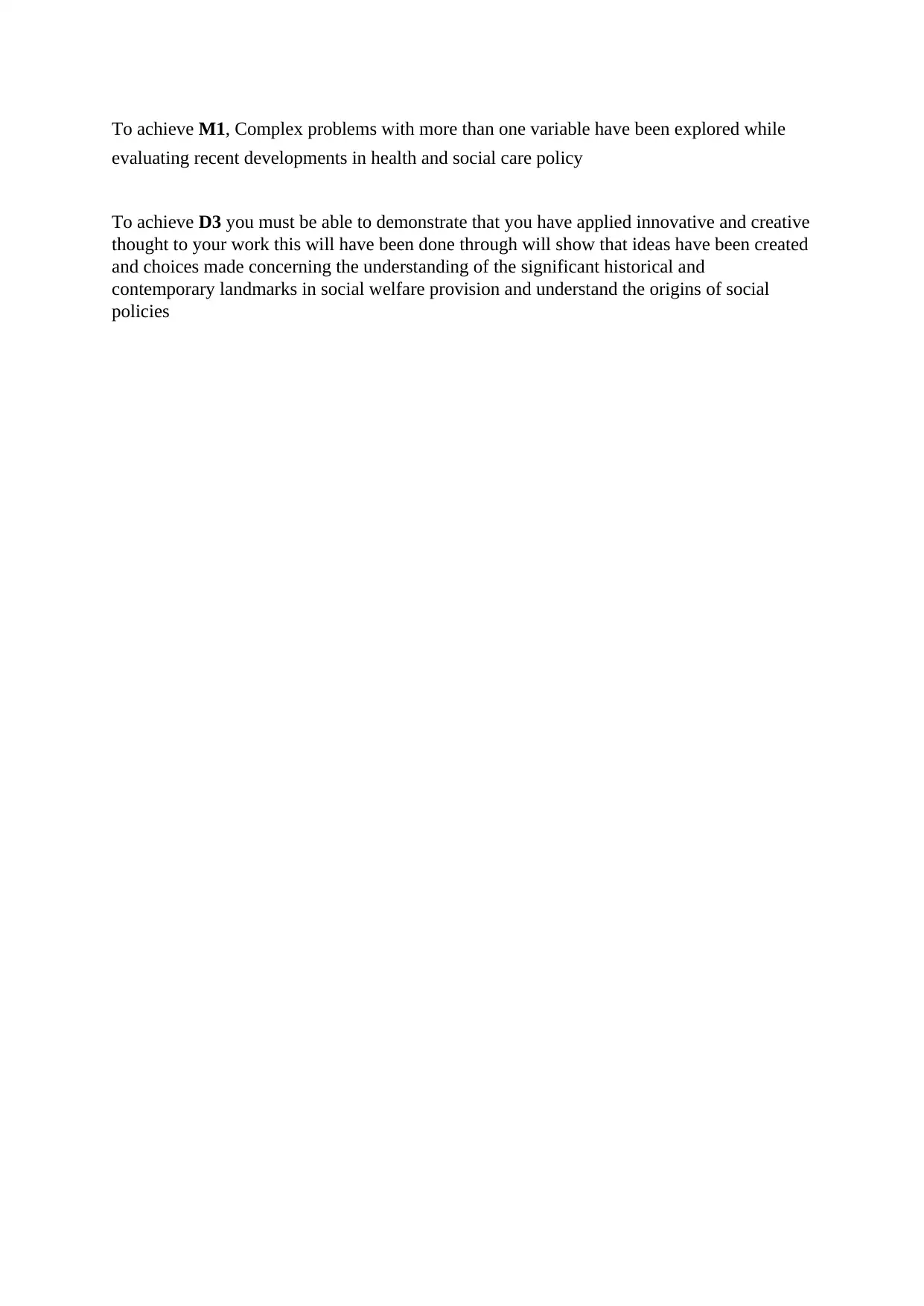
To achieve M1, Complex problems with more than one variable have been explored while
evaluating recent developments in health and social care policy
To achieve D3 you must be able to demonstrate that you have applied innovative and creative
thought to your work this will have been done through will show that ideas have been created
and choices made concerning the understanding of the significant historical and
contemporary landmarks in social welfare provision and understand the origins of social
policies
evaluating recent developments in health and social care policy
To achieve D3 you must be able to demonstrate that you have applied innovative and creative
thought to your work this will have been done through will show that ideas have been created
and choices made concerning the understanding of the significant historical and
contemporary landmarks in social welfare provision and understand the origins of social
policies
⊘ This is a preview!⊘
Do you want full access?
Subscribe today to unlock all pages.

Trusted by 1+ million students worldwide
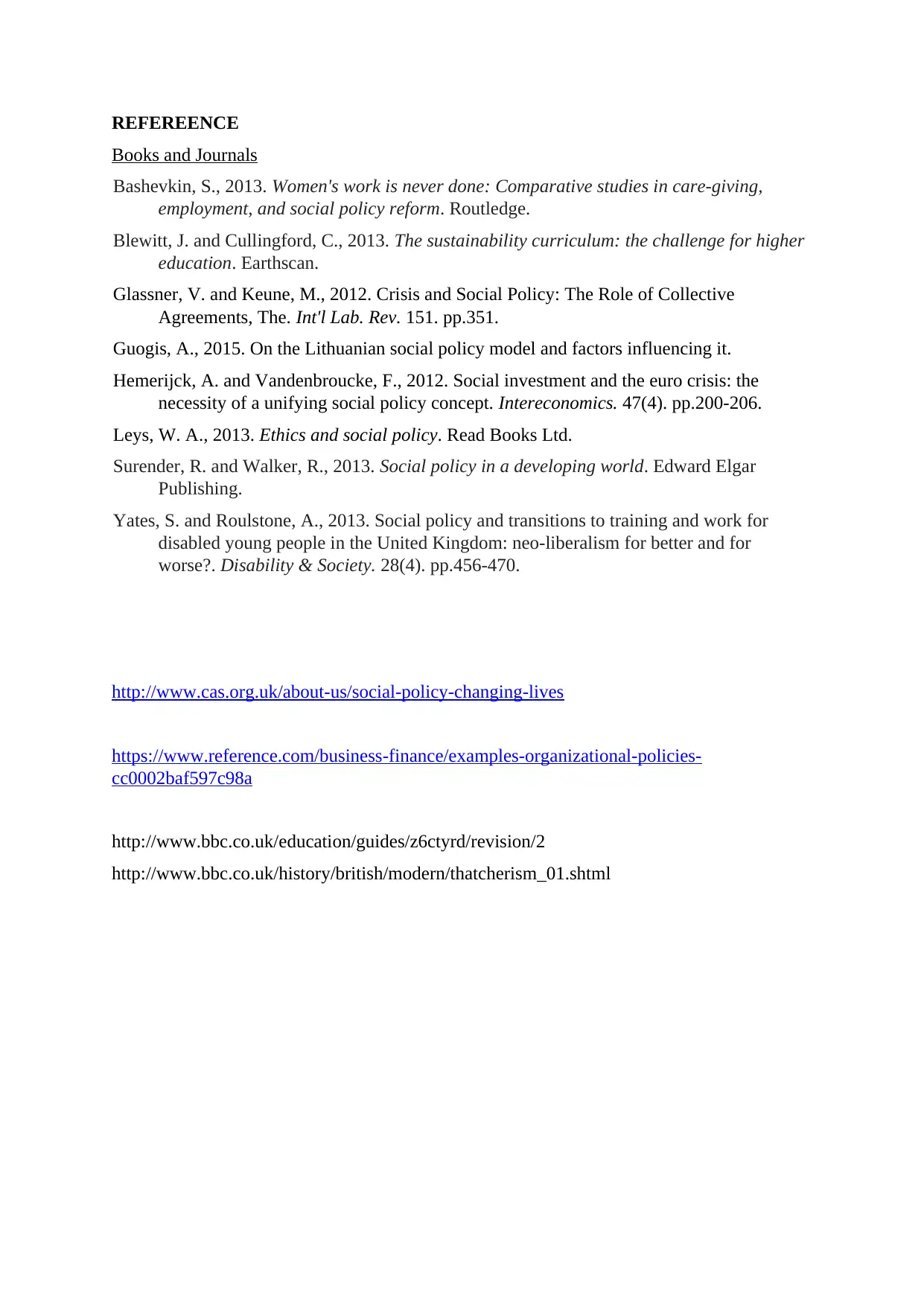
REFEREENCE
Books and Journals
Bashevkin, S., 2013. Women's work is never done: Comparative studies in care-giving,
employment, and social policy reform. Routledge.
Blewitt, J. and Cullingford, C., 2013. The sustainability curriculum: the challenge for higher
education. Earthscan.
Glassner, V. and Keune, M., 2012. Crisis and Social Policy: The Role of Collective
Agreements, The. Int'l Lab. Rev. 151. pp.351.
Guogis, A., 2015. On the Lithuanian social policy model and factors influencing it.
Hemerijck, A. and Vandenbroucke, F., 2012. Social investment and the euro crisis: the
necessity of a unifying social policy concept. Intereconomics. 47(4). pp.200-206.
Leys, W. A., 2013. Ethics and social policy. Read Books Ltd.
Surender, R. and Walker, R., 2013. Social policy in a developing world. Edward Elgar
Publishing.
Yates, S. and Roulstone, A., 2013. Social policy and transitions to training and work for
disabled young people in the United Kingdom: neo-liberalism for better and for
worse?. Disability & Society. 28(4). pp.456-470.
http://www.cas.org.uk/about-us/social-policy-changing-lives
https://www.reference.com/business-finance/examples-organizational-policies-
cc0002baf597c98a
http://www.bbc.co.uk/education/guides/z6ctyrd/revision/2
http://www.bbc.co.uk/history/british/modern/thatcherism_01.shtml
Books and Journals
Bashevkin, S., 2013. Women's work is never done: Comparative studies in care-giving,
employment, and social policy reform. Routledge.
Blewitt, J. and Cullingford, C., 2013. The sustainability curriculum: the challenge for higher
education. Earthscan.
Glassner, V. and Keune, M., 2012. Crisis and Social Policy: The Role of Collective
Agreements, The. Int'l Lab. Rev. 151. pp.351.
Guogis, A., 2015. On the Lithuanian social policy model and factors influencing it.
Hemerijck, A. and Vandenbroucke, F., 2012. Social investment and the euro crisis: the
necessity of a unifying social policy concept. Intereconomics. 47(4). pp.200-206.
Leys, W. A., 2013. Ethics and social policy. Read Books Ltd.
Surender, R. and Walker, R., 2013. Social policy in a developing world. Edward Elgar
Publishing.
Yates, S. and Roulstone, A., 2013. Social policy and transitions to training and work for
disabled young people in the United Kingdom: neo-liberalism for better and for
worse?. Disability & Society. 28(4). pp.456-470.
http://www.cas.org.uk/about-us/social-policy-changing-lives
https://www.reference.com/business-finance/examples-organizational-policies-
cc0002baf597c98a
http://www.bbc.co.uk/education/guides/z6ctyrd/revision/2
http://www.bbc.co.uk/history/british/modern/thatcherism_01.shtml
1 out of 10
Related Documents
Your All-in-One AI-Powered Toolkit for Academic Success.
+13062052269
info@desklib.com
Available 24*7 on WhatsApp / Email
![[object Object]](/_next/static/media/star-bottom.7253800d.svg)
Unlock your academic potential
Copyright © 2020–2025 A2Z Services. All Rights Reserved. Developed and managed by ZUCOL.




